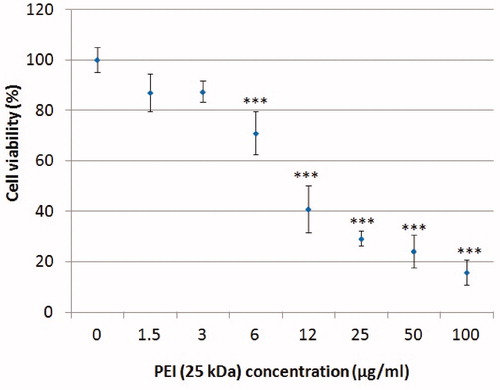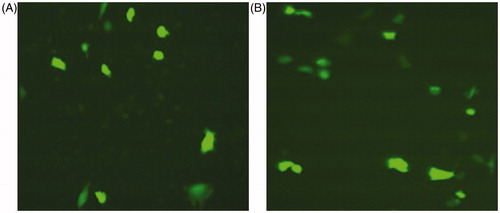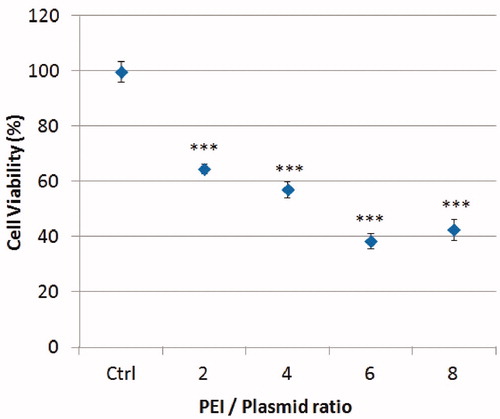Abstract
Gene therapy has emerged as an influential tool for treating the genetic and specific acquired disorders. Among all kinds of gene delivery systems, the cationic polymer polyethyleneimine (PEI) is considered as a promising non-viral gene delivery vector, although there are still concerns about its magnitude of cytotoxicity. While any cell insult leads to unfolded/misfolded protein accumulation and its consequent unfold protein response, evaluating the expression profile of ER-stress genes would be a sensitive indicator of cell stress. Beside cytotoxicity assays, real-time RT-PCR was used to investigate the effects of PEI nanoparticles on the endoplasmic reticulum. Treating Neuro2A cells revealed that PEI can induce cell toxicity in a concentration-dependent manner. Also, It increased the transcript levels of Grp78 (Bip), Atf4 and Chop, and splicing of Xbp1. To further optimize the transfection properties in Neuro2A cells, PEI was used to deliver a plasmid DNA containing GFP reporter. While different PEI/plasmid ratios revealed similar transfection efficiency, increasing the PEI/plasmid ratio led to induction of ER-stress markers. These results underscored that beside the effectiveness of PEI, using the lowest possible ratio of PEI/plasmid would minimize the detrimental effects of PEI on cells and confer it a beneficial therapeutic importance in nucleic acid delivery.
Introduction
Beside the potential application of treating diseases by gene therapy to replace dysfunctional genes in many hereditary disorders, it is currently considered as a new promising tool for eradicating acquired diseases, such as cancers, immune system disorders, and many viral or bacterial infections [Citation1–3].
Several gene transferring methods are available, categorized as viral vectors and non-viral artificial carriers [Citation4,Citation5]. Intensive immunogenic responses, in addition to other obstacles related to large scale production, limited loading capacity, and insertional mutagenesis of viruses have switched the use of viral vectors to non-viral delivery systems. Among these, polymer-based systems which provide ease of preparation, well-recognized physicochemical properties, such as having different molecular weights and degrees of branching, unrestricted trans-gene capacity, and considerable stability have recently earned substantial interest [Citation5,Citation6]. In this regard, one of the most highly efficient and interesting candidates is polyethyleneimine (PEI). Depending upon ethylenimine units repetition, PEI can be synthesized in two types of topology: linear and branched forms which have been used in a wide range of lengths and molecular weights [Citation7–9]. The positive charged PEI macromolecule can adhere to negative charged DNA and condense it completely by electrostatic interactions to form nano-size polycation/DNA complexes (polyplexes) leading to plasmid DNA protection against degradation and their uptake enhancement via endocytosis [Citation10].
Beside the increasing interest about PEI potential gene delivery benefits, its plausible cytotoxicity can limit its application in clinical situations [Citation11]. It has been shown that perturbation property of PEI results in destabilization of cellular organelles, such as mitochondria and endoplasmic reticulum [Citation11,Citation12]. In an intact cell, synthesized polypeptides transport into ER lumen and obtain a three-dimensional shape after undergoing protein folding and posttranslational modifications. PEI in turn can adversely affect the protein synthesis machinery of a cell leading to an increase in protein misfolding and accumulation of unfolded/misfolded proteins in the endoplasmic reticulum (ER) generally known as “ER stress” [Citation13].
To debate these conditions, a wide range of protective strategies have been known in eukaryotic cells, generally constitute unfolded protein response (UPR) composed of complexity of three discrete signalling pathways [Citation13,Citation14]. Dissociation of glucose-regulated protein/binding immunoglobulin protein (Grp78/Bip), as the central marker of UPR, is a common signal to other pathways triggered by pancreatic ER kinase (PERK), activating transcription factor 6 (Atf6) and inositol-requiring enzyme 1 (IRE1) [Citation14,Citation15]. The Overall net effect would be inhibition of general protein translation, synthesis and restoration. Also, it induces the selected UPR genes, such as chaperones, as well as oxidants and antioxidants detoxifying enzymes. Among all the key players involved, the expression profile of Grp78, activating transcription factor 4 (Atf4) and C/EBP homologous protein (Chop) are the most sensitive markers in detecting cellular damages in both pro-apoptotic and protective conditions. In addition, splicing of a 26 nucleotide from the unspliced X-box binding protein 1 (Xbp1) performed by IRE1 upon ER stress leads to Xbp1 activation. Spliced Xbp1 triggers the ER associated degradation (ERAD) machinery and also induces the transcription of some protein chaperons, such as Grp78 [Citation14,Citation15].
This study was performed to find the best concentration and different proportions per plasmid of PEI, mapping out its cytotoxic effects on Neuro2A using UPR markers. In this regard, PEI in various concentrations and also different proportions per plasmid was used to find out the feasible toxic consequences in a molecular aspect.
Materials and methods
Materials
Branched PEI (average MW25 kDa), N-[2-hydroxyethyl] piperazine-N0-[2-ethanesulfonic acid] (HEPES) were purchased from Sigma-Aldrich (Munich, Germany). Plasmid EGFP under the control of cytomegalovirus (CMV) promoter was obtained from Promega (Madison, WI). Dulbecco’s modified Eagle’s medium (DMEM) and fetal bovine serum (FBS) were prepared from GIBCO (Gaithersburg, MA). All solvents and chemicals were purchased from Sigma–Aldrich (Munich, Germany).
Polymer–DNA complex formation
PEI was diluted in HEPES buffered glucose (HBG) solution which consisted of 20 mM HEPES in 5% aqueous glucose solution. Different PEI dilutions were added to solutions of the plasmid (P) in the same solvent, mixed and incubated (30 min, room temperature) to form polyplexes at a range of polymer/plasmid ratios (weight/weight ratio). These polyplexes used in the experiment had the same concentration of free PEI (without plasmid).
Cell line and cell culture
Neuro2A murine neuroblastoma cells (ATCC® CCL-131™) were maintained at 37 °C, 5% CO2 and 100% humidity in DMEM (1 g/L glucose) supplemented with 10% fetal bovine serum, streptomycin at 100 mg/mL, penicillin at 100 units/mL, and 2 mM glutamine. After seeding the cells in 96-well plates (at a density of 1 × 104 cells/well) in 96-well plates and incubating for 24 h, they were treated with increasing concentrations of PEI (0, 3, 6, 12, and 25 μg/mL), or increasing weight:weight ratios of PEI/plasmid (0.5, 2, 4, and 6) for 3-(4,5-dimethylthiazol-2-yl)-2,5-diphenyltetrazolium bromide (MTT) assay. The same procedure was performed in six well plates (at a density of 1 × 106 cells/well) for total RNA extraction.
MTT assay
In vitro cytotoxicity of PEI polymer itself and PEI/plasmid polyplexes were evaluated by the method using MTT assay [Citation16]. The different concentrations of PEI, beside different PEI/plasmid ratios in the same condition of transfection protocol, were added to the cells. After 24 h of incubation, 20 μL of 5 mg/mL MTT in phosphate buffer saline (PBS) was added to each well and the cells were further incubated (4 h, 37 °C). Medium containing unreacted dye was discarded and 100 μL of isopropanol was added to dissolve the formazan crystal formed by live cells. Optical absorbance was measured at 590 nm (reference wavelength 630 nm) using microplate reader (Statfax–2100, Awareness Technology, Palm City, FL), and cell population was evaluated as percent relative to untreated control cells. Values of metabolic activity are presented as means ± SD of triplicates.
Transfection experiments
Transfections were performed with polyplexes at the different PEI/plasmid ratios. Polyplexes were prepared by mixing various concentrations of PEI in 50 μL HBG with plasmid DNA containing permuted enhanced GFP (PEGFP) gene sequence (2 μg in 50 mL HBG) reaching to a final volume of 100 μL HBG. Ten microliters of polyplexes (equivalent of 200 ng pDNA) solution were added to each Neuro2A culture well and incubated for 4 h at 37 °C. The medium was removed, replaced with 100 μL of serum supplemented DMEM, and incubated for 24 h at 37 °C. To evaluate the effective penetration of polyplexes into the Neuro2A cells, visualization of Green fluorescent protein (GFP) expression was made using fluorescence microscopy carried out by a Nikon microscope equipped with a Xenon lamp power supply and a GFP filter set (Chromatechnology Corp., Brauleboro, VT).
Total RNA extraction and RT-PCR
Total RNA was isolated from cells in each well using the RNA isolation Kit according to manufacturer’s directions (DENA zist Asia, Iran). cDNA was synthesized from 1 μg of the RNA using MMLV reverse transcriptase, Random Hexamer Primer, and RNase inhibitor (all reagents from Thermo Fisher Scientific, Waltham, MA). For quantity assessment, RNA and cDNA samples were analysed by a NanoDrop spectroscopy analyzer (Epoch, Biotech, Sugar Land, TX). Also, extracted total RNA was checked for 18 and 28 S rRNA bands visualization by 1% (w/v) agarose gel electrophoresis.
PCR and real-time RT-PCR
Amplification of Grp78, Chop, and Atf4 mRNA using Primus 96 gradient thermocycler (Biotech, Germany) with Taq polymerase (Thermo Fisher Scientific, Waltham, MA) was assessed and normalized against β-act as housekeeping gene. The thermal cycle was programmed for 3 min at 94 °C for initial denaturation, following by 30 cycles of 30 s at 94 °C for denaturation, 30 s at 60 °C for annealing (for all genes), 1 min at 72 °C for extension, and 10 min at 72 °C for the final extension. Real-time reverse transcriptase polymerase chain reaction (RT-PCR) primers were designed (Primer Premier v5, Biosoft International) according to the NCBI mRNA sequences bank and shown in . Transcript levels of these genes in real-time were assessed using SYBR Green Maxima (SYBR Green/ROX qPCR Master Mix, Thermo Fisher Scientific, Waltham, MA) and the real-time Rotor-Gene 6000 Rotary Analyzer (Roche light cycler 480; Idaho Technology Inc., Salt Lake City, UT) according to the manufacturer’s directions (Thermo Fisher Scientific, Waltham, MA). PCR products were separated at 100 V for 30 min by 1% (w/v) (for β-act, Chop, Atf4 and Grp78) agarose gel electrophoresis 1x TAE buffer and detected by a Syngene gel imaging system (InGenius LHR, Cambridge, UK). For detection of Xbp1 splicing, the conventional PCR was performed and 205 and 179 bp products were detected on a 2.5% (w/v) agarose gel. Relative quantification of splicing was assessed via band densitometry of spliced/unspliced forms comparison performed by Scion Image software (Beta 4.0.2, Scion Corporation, Frederick, MD). In brief, a curve describing the variation of the intensity of every lane was plotted while the area under the curve was proportional to the intensity of the band and to the relative amount of the DNA in each lane.
Table 1. Primer sequences for real-time RT-PCR and product size of the candidate genes.
Statistical analysis
Relative fold changes in Grp78, Atf4 and Chop transcript levels were assessed via the 2−ΔΔct method and analysed by one-way ANOVA followed by the Tuckey–Kramer multiple comparison tests (GraphPadInStat version 3.0; GraphPad Software Inc., San Diego, CA). p < .05 was considered as significant.
Results
PEI provokes toxic effects on neuro2A cells
To assess the potential toxic effects of PEI on neurons, neuro2A cells were treated with the different concentrations of PEI using HBG medium. MTT assay revealed that PEI has detrimental in vitro effects on cells by decreased percentage of metabolic activity in a concentration-dependent manner (, p = .0001).
Increase in concentration of PEI can induce Grp78 expression
Transcript levels of Grp78 as the central UPR marker triggering both the proapoptotic and anti-apoptotic pathways [Citation14,Citation15] were evaluated in neuronal cells exposed to the different concentrations of PEI. According to the results, PEI elevated the transcription of Grp78 (p = .04) in a concentration-dependent manner. Interestingly, a reverse trend was evident in extremely high PEI concentration (25 μg/mL) demonstrating a robust suppression of Grp78 in neuro2A cells ().
Figure 2. Effects of PEI on transcription level of ER-stress genes in Neuro2A cells. A) Grp78; B) Atf4; and C) Chop mRNA levels were assessed by real-time RT-PCR. The results are normalized against β-act as a housekeeping gene and are shown as means ± SEM. *: p < .05 and ***: p < .001 compared to control group, RFC: relative fold change; Treatments were performed in triplicates.
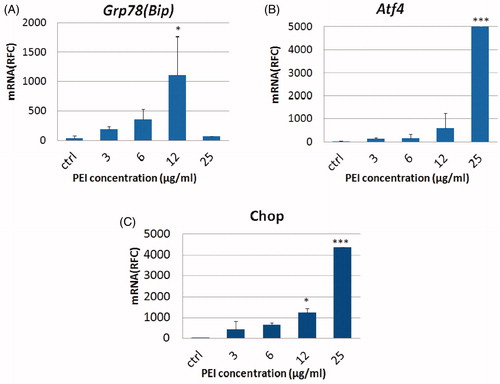
Atf4 gene expression is induced by increasing the PEI concentration
Considering the imperative role of Grp78 in inducing Atf4 through both the proapoptotic and antiapoptotic pathways of UPR [Citation14,Citation15], the effects of PEI on Atf4 transcript levels were evaluated. The real-time RT-PCR data indicated that the higher concentrations of PEI can result in more induction of Atf4 expression (p = .0001) with the highest transcript levels resulted by the concentration of 25 μg/mL exceeding 19,000 fold changes compared to the control littermates ().
Increased concentrations of PEI can augment chop transcript levels
Chop is known as a proapoptotic mediator of growth arrest and cell death [Citation17]. Its expression is under the control of Atf4 in severe or prolonged stressed conditions leading to switch the survival signals to proapoptotic pathways and can be concerned as a good cell stress indicator. Higher concentrations of PEI led to enhanced Chop expression in a concentration-dependent manner (p = .0001), especially in cells treated with PEI concentration of 25 μg/mL, which depicted a three-fold noticeable rise (from ∼1500 to ∼4500 RFC) ().
PEI treatment activates Xbp1
Upon accumulation of unfolded proteins in the ER and resultant ER-stress, the Xbp1 expression is induced via an Atf6-dependent signal. More outstandingly, in addition to the above mentioned consequences of Grp78 dissociation, the mRNA of Xbp1 is processed to its active form by an unconventional splicing phenomenon mediated by the endonuclease IRE1. Resulting loss of 26 nucleotides in the spliced mRNA causes a frame-shift and creates the spliced isoform of Xbp1 which is functionally active transcription factor. The isoform encoded by the unspliced mRNA is constitutively expressed, and thought to function as a negative feedback regulator of spliced Xbp1 which shuts off transcription of target genes during the recovery phase of ER stress [Citation15,Citation16]. Herein, it was perceived that PEI can increase the Xbp1 activation in a concentration-dependent manner by relative band densitometry of spliced/unspliced forms ratio ().
Figure 3. Xbp1 splicing during PEI-induced ER stress. (A) Xbp1 splicing was detected by conventional PCR on a 2.5% agarose gel electrophoresis system. Four hours exposure of Neuro2A cells to increasing concentrations of PEI induced splicing of Xbp1 by separated bands of 205 and 179 bp. (B) band densitometry of spliced/unspliced (S/US) Xbp1 transcripts in Neuro2A cells treated with increasing concentrations of PEI. After plotting the variation of the intensity of every lane, the area under the curve for each band was measured and the results are shown as values of S/US ratio.
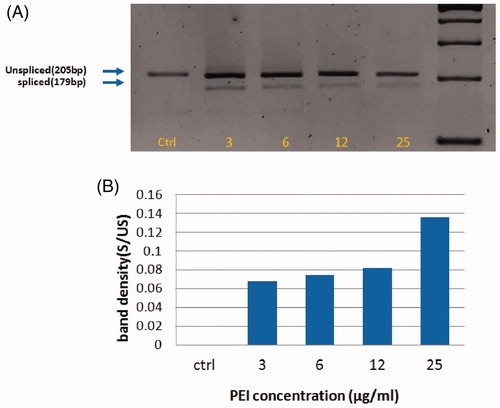
Neuro2A cells were transfected by PEI
Considering the ultimate goal of using PEI as a delivery vector of nucleic acids, PEI was used to deliver reporter gene for Enhanced Green Fluorescence Protein (EGFP). Murine neuroblastoma cells were seeded at a density of 8 × 104 cells per well in 12-well plates. Complexes of plasmid DNA (pEGFP) and PEI were added to the wells. After 4 h incubation, the medium was removed and replaced with fresh medium. The transfected cells were visualized determined using the fluorescent microscope – JuLI™ FL ().
PEI/plasmid complex can induce toxic effects on neuro2A cells
To assess the potential toxic effects of polyplexes, neuro2A cells were treated with the different ratios of PEI/plasmid in HBG medium. MTT assay revealed that PEI had detrimental effects on Neuro2A cells by decreased percentage of cell metabolic activity in a concentration-dependent manner (, p < .05).
Increased ratios of PEI/plasmid result to higher expression of Grp78
Considering the effective transfection of the plasmid using PEI, we aimed to evaluate the undesirable effects of this combined form to further optimize the efficient DNA delivering conditions. In this regard, different proportions of PEI/plasmid were used to disclose the best optimized ratio. Using quantitative relative gene expression analyses, the expression levels of ER-stress genes were evaluated in Neuro2A cells treated with different ratios of PEI/plasmid. Interestingly, the transcript levels of Grp78 as the most important maker of ER-stress was augmented while the neurons were treated with increasing ratios of PEI/plasmid (, p = .0001).
Figure 6. Transcription level of ER-stress genes in Neuro2A cells incubated with different PEI/plasmid ratios. A) Grp78; B) Atf4; and C) Chop mRNA levels were assessed by real-time RT-PCR. The results are normalized against β-act as a housekeeping gene and are shown as means ± SEM. *: p < .05 and ***: p < .001 compared to control group, RFC: relative fold change; Treatments were performed in triplicates.
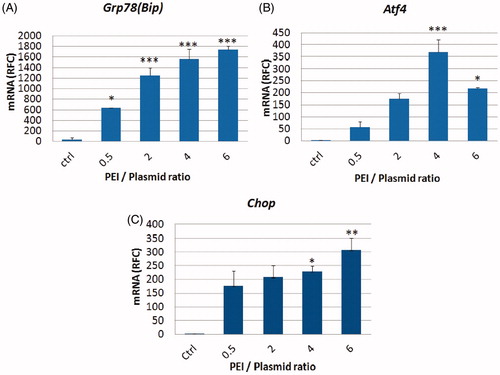
Atf4 gene expression was induced by increasing the PEI/plasmid ratios
As mentioned earlier, induction of Grp78 can increase the transcription of Atf4 through PERK activation [Citation15]. The real-time RT-PCR results indicated that Atf4 mRNA levels were enhanced by increasing the ratio of PEI/plasmid (p = .0003). Noticeably, the expression level followed a reverse trend in PEI/plasmid = 6 ratio group with a significant drop compared to the ratio of 4 littermates ().
Increasing ratios of PEI/plasmid results in induction of chop gene expression
Considering the inducing effect of ATF4 on Chop expression, the mRNA levels of this growth arrest mediator was assessed [Citation14,Citation15]. The real-time RT-PCR revealed that Chop expression followed an increasing trend while the ratios of PEI/plasmid were getting higher from 0.5 to 6 (, p = .0029).
Increase in PEI/plasmid ratio results in activation of Xbp1
During continued stress conditions, Xbp1 mRNA splicing is induced via an IRE1-dependent pathway. This spliced form is translated to protein and acts as a potent transcription factor that induces Grp78 expression. Also, Xbp1 is induced by activated Atf6, therefore it is thought to be an important marker reflecting both IRE1 and Atf6 signalling in response to ER stress [Citation18]. Our results underscored that increasing the ratio of PEI/plasmid can enhance the mRNA levels of unspliced Xbp1. Moreover, it augments the ratio of spliced/unspliced forms by relative band densitometry ().
Figure 7. Xbp1 splicing during PEI-induced ER stress. A) Xbp1 splicing was detected by conventional PCR on a 2.5% agarose gel electrophoresis system. Four hours exposure of Neuro2A cells with increasing ratios of PEI/plasmid induced splicing of Xbp1 by two separate bands of 205 and 179 bp. B) band densitometry of spliced/unspliced (S/US) Xbp1 transcripts in Neuro2A cells treated with increasing ratios of PEI/plasmid.
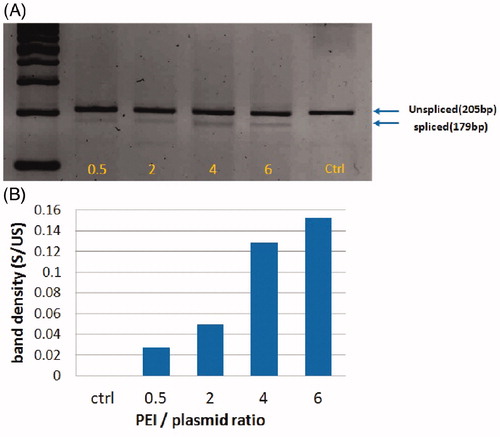
Discussion
Interest in using PEI as a non-viral vector of gene delivery has surged in recent years, although its plausible detrimental effects remained open to question [Citation19]. In this study, we found that PEI induced toxic effects on Neuro2A cells in a concentration-dependent manner. This toxicity was accompanied by a significant change in the transcription profile of ER-stress genes, such as Grp78, Atf4 and Chop. In addition, activation of Xbp1 was induced by PEI. Moreover, PEI was used to deliver pEGFP reporter considering the ultimate ambition of using PEI as a medicinal tool for delivering nucleic acids. While fluorescence imaging of cells revealed similar transfection efficiencies of different PEI/plasmid ratios, MTT assay underscored that higher ratios caused more severe cytotoxic effects on cells. This toxicity was also obvious on the expression profile of UPR related genes.
PEI can induce cytotoxicity [Citation8,Citation20], therefore in the present study, MTT assay was used to assess in vitro metabolic activity of cells. However the exact mechanisms remain unclear [Citation8,Citation20]. Recent molecular studies have shown that the underlying mechanisms in PEI-induced cytotoxicity were multi-factorial and involved in necrotic and apoptotic pathways. It is now believed that PEI is likely to cause ER dysfunction which might consequently trigger ER apoptotic signals known as UPR [Citation11]. In this study, we focused on this precise and sensitive feature of cell toxicity regarding disruption of protein folding machinery in the ER and resultant UPR. Indeed, by being focused on expressional responsive changes in UPR markers of PEI-induced cell toxicity, a more precise, sensitive and accurate judgment about the plausible cytotoxic effects can be achieved.
PEI is available in a broad range of molecular weights, from <1000 Da to 1600 KDa. It is commonly believed that the most suitable molecular weight of PEI for gene transfer ranges between 5 and 25 KDa [Citation2]. It is well-known that transfection efficiency of PEI is increased with its molecular weight. However, cytotoxicity properties are increased in a molecular weight-dependent manner, presumably due to aggregation of large clusters of the cationic polymer on the outer layer of cell membrane. Herein, 25 KDa molecular weight of PEI was used to achieve the best transfection properties.
It has been postulated that transfection efficiency depends, in a still poorly-defined way, on the concentration of PEI [Citation10,Citation21,Citation22], whereas higher concentrations lead to increased cytotoxicity [Citation23,Citation24]. This might be due to a direct cytotoxic process generally known as immediate toxicity, mostly allied with the free forms of PEI [Citation25,Citation26]. Similarly, we found a significant increasing trend in transcript levels of Atf4 and Chop as well as Xbp1 splicing following treatment of neurons with increasing concentrations of PEI (3, 6, 12, and 25 μg/mL). More intriguingly, the same increasing trend was seen for Grp78 mRNA levels, except in 25 μg/mL PEI-treated group. In line to these findings, several reports have also disclosed overexpression of Atf4 and Chop under severe stress conditions associated with Grp78 down regulation [Citation27,Citation28]. In contrast to other studies indicating post-transcriptional changes in Bip (Grp78) [Citation29,Citation30], we reported that down regulation of Grp78 occurred at mRNA level as a signature of the degenerating process in cells. Getting together, using 25 μg/mL concentration of PEI seemed to be too toxic inducing a severe cell stress and struggling the application of this concentration as a reliable gene delivery system.
The delayed toxicity underlined by apoptotic signals is mostly resulted from endocytosis of the PEI/plasmid complexes. These complexes enter the cell more readily and after decomplexation, the free polymers are again able to interact with cellular components and inhibit normal cellular processes [Citation26]. Therefore, an imperative point would be decision about the least toxic ratio of PEI/plasmid. When the PEI/plasmid ratio increases, more condensation results and lower size of polyplexes exhibits higher cytotoxic properties due to more electrostatic interaction with the negatively charged cell surface [Citation31]. Additionally, increasing the PEI/plasmid ratio makes complexes with higher buffering capacities which presumably enables more efficient endolysosomal escape [Citation21]. Increasing the PEI/plasmid ratio can also boost the amount of uncomplexed PEI which deposits on the cell surface and subsequently enters the cell via endocytosis [Citation5]. Indeed, free PEI is essential for modification and permeabilization of endosomal membrane structure. One interpretation of this is that the free PEI weakly associates with the polyplexes and enhances the surface charge of the complex giving higher affinity for the negatively charged cell membrane [Citation7].
Our present results declared that expression of Grp78 was elevated when treating the cells with higher ratios of PEI/plasmid. This might be due to higher concentration of free PEI on the cell surface before entering the cell. Also, it can be related to higher intracellular concentration of PEI after decomplexation in the cell. The Chop expression and Xbp1 splicing also imitated the same trend, although Atf4 expression followed a unique pattern. It has been reported that spliced-Xbp1, as a stable transcription activator, had diverse targets including ER chaperons and HSP40 family member, P58IPK. When P58IPK protein is induced, it binds and inhibits PERK, thereby providing a negative feedback loop that relieves the PERK-mediated transcriptional block, especially on Atf4 expression [Citation32]. Indeed, dissociation of Grp78 activates PERK which in turn inhibits the general protein translation and synthesis in the cell via phosphorylating eukaryotic initiation factor 2α (elf2α). Phosphorylated elf2α also activates Atf4 via a parallel pathway to bypass the eIF2α-dependent pathway. Our results underlay that the negative feedback was evident in Atf4 transcriptional level after treating the cells with PEI/plasmid ratio of 6. This was not the case in PEI (only) treatment groups. By comparing the relative fold changes of Atf4 and Chop mRNA levels when cells are treated with PEI or PEI/plasmid complexes (∼5000 vs. ∼400), one assumption would be the significance of depositing huge free PEI aggregates on the cell membrane and direct necrotic signal, rupturing the cell membrane [Citation5,Citation8,Citation25,Citation31]. The resultant robust increase in Atf4 and Chop transcription overcomes the controlling negative feedback mediated by P58IPK [Citation32].
Conclusions
In this study, PEI was used as a non-viral vector for gene delivery in different concentrations and PEI/plasmid ratios. MTT fluorescence microscopy, PCR and real-time RT-PCR were used to evaluate cytotoxicity effect, transfection efficiency and ER stress caused by PEI. Generally, in addition to the favourable properties of PEI mediated gene delivery, it seems that optimization of conditions, such as choosing the right concentration of PEI as well as the least possible PEI/plasmid ratio, can be imperative in attenuation of unwanted cytotoxic effects.
Acknowledgements
The authors would like to thank Dr. Mohammad Hossein Nazem Shirazi, Dr. Hesam Dehghani and Leila Gholami for their technical supports. This study was supported by a grant (#25428) from Ferdowsi University of Mashhad Research and Technology Council.
Disclosure statement
The authors report no conflicts of interest.
Additional information
Funding
References
- Lungwitz U, Breunig M, Blunk T, et al. Polyethylenimine-based non-viral gene delivery systems. Eur J Pharm Biopharm. 2005;60:247–266.
- Neu M, Fischer D, Kissel T. Recent advances in rational gene transfer vector design based on poly(ethylene imine) and its derivatives. J Gene Med. 2005;7:992–1009.
- Hanna E, Rémuzat C, Auquier P, et al. Gene therapies development: slow progress and promising prospect. J Mark Access Health Policy. 2017;5:1265293.
- Jeong JH, Kim SW, Park TG. Molecular design of functional polymers for gene therapy. Prog Polym Sci. 2007;32:1239–1274.
- Merdan T, Kopec˘ek J, Kissel T. Prospects for cationic polymers in gene and oligonucleotide therapy against cancer. Adv Drug Deliv Rev. 2002;54:715–758.
- Dehshahri A, Oskuee RK, Shier WT, et al. Gene transfer efficiency of high primary amine content, hydrophobic, alkyl-oligoamine derivatives of polyethylenimine. Biomaterials. 2009;30:4187–4194.
- Dai Z, Gjetting T, Mattebjerg MA, et al. Elucidating the interplay between DNA-condensing and free polycations in gene transfection through a mechanistic study of linear and branched PEI. Biomaterials. 2011;32:8626–8634.
- Moghimi SM, Symonds P, Murray JC, et al. A two-stage poly (ethylenimine)-mediated cytotoxicity: implications for gene transfer/therapy. Mol Ther. 2005;11:990–995.
- Song S, Qian Y, Wu Q, et al. Properties of fluids composed of polyelectrolyte and double-chain anionic surfactant: branched polyethyleneimine and sodium bis (2-ethylhexyl) sulfosuccinate. J Dispers Sci Technol. 2014;35:1449–1459.
- Godbey W, Barry MA, Saggau P, et al. Poly(ethylenimine)-mediated transfection: a new paradigm for gene delivery. J Biomed Mater Res. 2000;51:321–328.
- Parhamifar L, Larsen AK, Hunter AC, et al. Polycation cytotoxicity: a delicate matter for nucleic acid therapy—focus on polyethylenimine. Soft Matter. 2010;6:4001–4009.
- Unfried K, Albrecht C, Klotz LO, et al. Cellular responses to nanoparticles: target structures and mechanisms. Nanotoxicology. 2007;1:52–71.
- Todd DJ, Lee A-H, Glimcher LH. The endoplasmic reticulum stress response in immunity and autoimmunity. Nat Rev Immunol. 2008;8:663–674.
- Yoshida H. ER stress and diseases. FEBS J. 2007;274:630–658.
- Inagi R. Endoplasmic reticulum stress as a progression factor for kidney injury. Curr Opin Pharmacol. 2010;10:156–165.
- Hetz C, Chevet E, Harding HP. Targeting the unfolded protein response in disease. Nat Rev Drug Discov. 2013;12:703–719.
- Oyadomari S, Mori M. Roles of CHOP/GADD153 in endoplasmic reticulum stress. Cell Death Differ. 2004;11:381–389.
- Hirota M, Kitagaki M, Itagaki H. Quantitative measurement of spliced XBP1 mRNA as an indicator of endoplasmic reticulum stress. J Toxicol Sci. 2006;31:149–156.
- Yuan Y, Liu C, Qian J, et al. Size-mediated cytotoxicity and apoptosis of hydroxyapatite nanoparticles in human hepatoma HepG2 cells. Biomaterials. 2010;31:730–740.
- Fischer D, Bieber T, Li Y, et al. A novel non-viral vector for DNA delivery based on low molecular weight, branched polyethylenimine: effect of molecular weight on transfection efficiency and cytotoxicity. Pharm Res. 1999;16:1273–1279.
- Godbey W, Wu KK, Mikos AG. Poly(ethylenimine) and its role in gene delivery. J Control Release. 1999;60:149–160.
- Kircheis R, Wightman L, Wagner E. Design and gene delivery activity of modified polyethylenimines. Adv Drug Deliv Rev. 2001;53:341–358.
- Choi YJ, Kang SJ, Kim YJ, et al. Comparative studies on the genotoxicity and cytotoxicity of polymeric gene carriers polyethylenimine (PEI) and polyamidoamine (PAMAM) dendrimer in Jurkat T-cells. Drug Chem Toxicol. 2010;33:357–366.
- Yue Y, Jin F, Deng R, et al. Revisit complexation between DNA and polyethylenimine – effect of uncomplexed chains free in the solution mixture on gene transfection. J Control Release. 2011;155:67–76.
- Lee MH. Apoptosis induced by polyethylenimine/DNA complex in polymer mediated gene delivery. Bull Korean Chem Soc. 2007;28:95–98.
- Lv H, Zhang S, Wang B, et al. Toxicity of cationic lipids and cationic polymers in gene delivery. J Control Release. 2006;114:100–109.
- Penas C, Font-Nieves M, Forés J, et al. Autophagy, and BiP level decrease are early key events in retrograde degeneration of motoneurons. Cell Death Differ. 2011;18:1617–1627.
- Yang GH, Li S, Pestka JJ. Down-regulation of the endoplasmic reticulum chaperone GRP78/BiP by vomitoxin (Deoxynivalenol). Toxicol Appl Pharmacol. 2000;162:207–217.
- Gülow K, Bienert D, Haas IG. BiP is feed-back regulated by control of protein translation efficiency. J Cell Sci. 2002;115:2443–2452.
- Rosengren V, Johansson H, Lehtiö J, et al. Thapsigargin down-regulates protein levels of GRP78/BiP in INS-1E cells. J Cell Biochem. 2012;113:1635–1644.
- Gao JQ, Zhao QQ, Lv TF, et al. Gene-carried chitosan-linked-PEI induced high gene transfection efficiency with low toxicity and significant tumor-suppressive activity. Int J Pharm. 2010;387:286–294.
- Szegezdi E, Logue SE, Gorman AM, et al. Mediators of endoplasmic reticulum stress-induced apoptosis. EMBO Rep. 2006;7:880–885.

